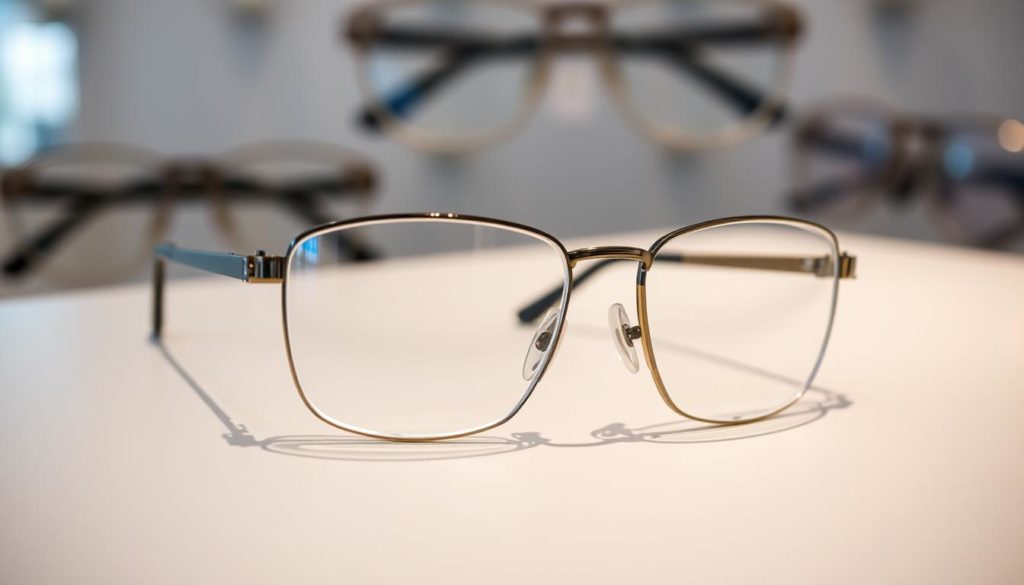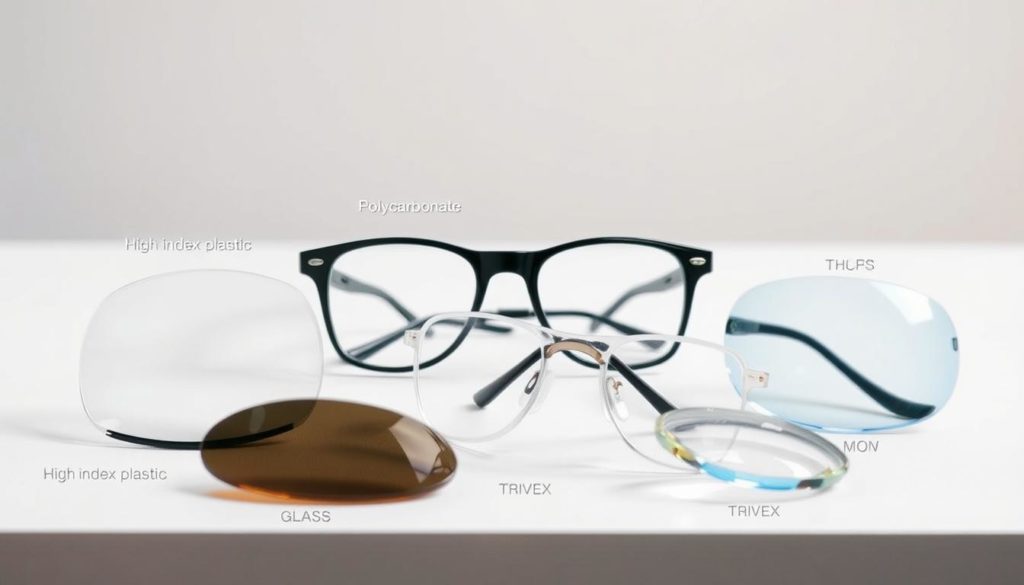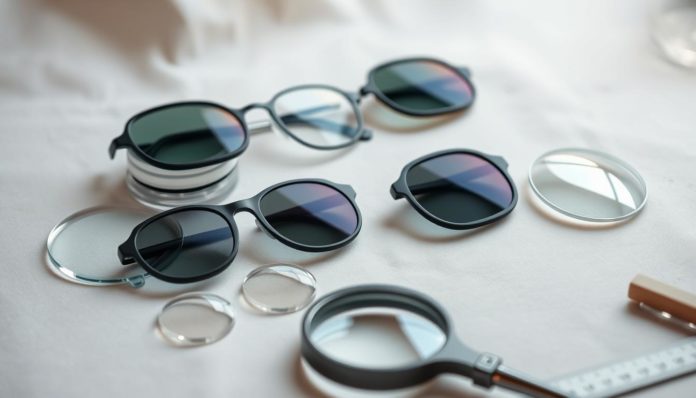Did you know about 75% of adults in the United States wear glasses or contact lenses? This shows how crucial it is to pick the right lenses for glasses. They improve your vision, comfort, and style.
Choosing the right glasses lenses involves several factors. You need to think about the lens material, type of vision correction, coatings, and your lifestyle. Your glasses are not just for seeing better. They’re also a statement piece and a way to take care of your eyes.
Whether you need single vision lenses for daily use, progressive lenses for multiple needs, or high-index lenses for a slim feel, knowing your options is key. This knowledge helps you make the best choice for your needs.
Understanding Your Prescription Lenses for Glasses
Choosing the right prescription lenses for glasses is important. Each type corrects different vision problems. Knowing which one you need is key.
Single Vision Lenses
Single vision lenses are great for those who need correction for one field of vision. They work for distance or near vision. They’re simple and often chosen for reading or driving.
Progressive Lenses
Progressive lenses offer a smooth transition between different vision distances. They’re perfect for those needing correction for more than one field. They improve clarity and eliminate the need for multiple glasses.

Bifocal and Trifocal Lenses
Bifocal and trifocal lenses are for those needing correction for two or three vision distances. Bifocals have two segments with a visible line. Trifocals have an extra segment for intermediate vision. They’re great for activities that require frequent focus changes.
- Bifocal Lenses
- Distance vision correction
- Near vision correction
- Trifocal Lenses
- Distance vision correction
- Intermediate vision correction
- Near vision correction
Different Types of Lens Materials for Eyeglasses
Choosing the right lens material for your eyeglasses is important. There are three main types: plastic, polycarbonate, and high-index lenses. Each has its own benefits and features.

Plastic Lenses
Plastic lenses are a favorite because they’re affordable and light. They’re great for people with mild to moderate vision problems. These lenses are made from CR-39 plastic and are clear and easy to tint.
Polycarbonate Lenses
Polycarbonate lenses are tough and perfect for kids and sports fans. They’re much stronger than other lenses and protect well. Plus, they block UV rays for extra safety.
High-Index Lenses
High-index lenses are best for those with strong prescriptions. They’re thinner and lighter, making glasses more comfortable. These lenses also look sleek and don’t sacrifice quality.
| Lens Type | Characteristics | Ideal Use |
|---|---|---|
| Plastic Lenses | Lightweight, Affordable, Optical Clarity | Low-to-Moderate Prescriptions |
| Polycarbonate Lenses | Impact-Resistant, UV Protection | Children, Sports Enthusiasts |
| High-Index Lenses | Thinner, Lighter, Sleek Appearance | High Prescriptions |
Picking the Right Lenses for Glasses
Choosing the right lenses for glasses involves many factors. You need to think about the prescription strength, comfort, style, and your daily activities. These elements ensure your glasses fit perfectly.
Let’s explore some key points to consider:
- Prescription Strength: The strength of your prescription affects the type of lens you need. High prescriptions often require thinner, lighter high-index lenses.
- Comfort: The weight and material of the lenses impact comfort. Polycarbonate lenses are light and durable, perfect for those who are active.
- Aesthetic Preferences: Some prefer lenses that look slim and don’t distort. High-index lenses offer a sleek look, even for strong prescriptions.
- Daily Activities: Your lifestyle is important. For example, outdoor activities may require lenses with UV protection or transitions.
It’s crucial to find lenses that balance functionality, quality, and cost. Personalized lenses improve clarity and comfort in different lighting and environments. Here’s a table to help you compare:
| Type of Lens | Prescription Range | Key Features | Ideal For |
|---|---|---|---|
| Single Vision Lenses | Low to moderate | Simplicity, affordability | General use |
| Progressive Lenses | Moderate to high | Multiple focal points | Multi-distance vision needs |
| High-Index Lenses | High | Thinner, lighter | Strong prescriptions |
| Polycarbonate Lenses | All ranges | Impact-resistant, lightweight | Active lifestyles |
By carefully considering these factors, you can choose the right lenses for your glasses. They should meet your vision and lifestyle needs.
Lens Coatings for Eyeglasses
Choosing the right lens coatings for eyeglasses is key. They make your glasses work better and last longer. These coatings also make your glasses more comfortable to wear.
Anti-Reflective Coatings
Anti-reflective coatings cut down on glare from screens and headlights. They make your lenses clearer and your glasses look cleaner. Great for people who use digital devices a lot or drive at night.
Scratch-Resistant Coatings
Scratch-resistant coatings are essential for keeping your lenses scratch-free. They protect your lenses from daily wear and tear. This coating is perfect for active people or those who often drop their glasses.
UV Protection
UV protection shields your eyes from harmful UV rays. UV rays can cause serious eye problems like cataracts and macular degeneration. It’s important to wear lenses with UV protection, especially if you spend time outside.
| Coating Type | Benefits | Ideal For |
|---|---|---|
| Anti-Reflective Coatings | Reduces glare, enhances vision and appearance | Digital device users, drivers |
| Scratch-Resistant Coatings | Prevents lens scratches, extends lens life | Active individuals, children |
| UV Protection | Blocks harmful UV rays, prevents eye damage | Outdoor enthusiasts, everyone |
Choosing Between Standard and High-Definition Lenses
When picking between standard and high-definition lenses, knowing their benefits is key. Standard lenses are a common choice for their basic vision correction. They are familiar to many.
High-definition lenses, however, offer clearer vision. They use new tech to give a sharper view. This makes them great for complex eye needs or those who use digital devices a lot.
Let’s compare the two lens options for eyeglasses:
| Feature | Standard Lenses | High-Definition Lenses |
|---|---|---|
| Vision Clarity | Adequate | Exceptional, with reduced glare and aberrations |
| Manufacturing Technique | Traditional | Advanced |
| Best For | General use | Complex prescriptions, digital device users |
In conclusion, your choice between standard and high-definition lenses depends on your needs and lifestyle. High-definition lenses can greatly improve your vision, especially if you value clarity and precision.
Tips for Choosing Glasses Lenses Based on Lifestyle
Finding the right lenses for your glasses is all about your daily life. Whether you’re into sports, office work, or fashion, the right lenses can really help.
Sports and Outdoor Activities
For sports and outdoor fans, sports lenses are perfect. They’re tough and protect your eyes from UV rays. They also cut down glare and improve your view.
Polycarbonate or Trivex materials are great for their strength. Plus, polarized lenses help with glare from water or snow.
Office and Computer Use
For those staring at screens all day, computer lenses are essential. They block blue light to ease eye strain. Anti-reflective coatings also reduce glare from lights and screens.
Fashion and Aesthetics
For style lovers, fashion-forward lenses are key. Look for lightweight, thin high-index lenses that are both stylish and practical. Also, consider lenses with trendy tints and gradients for your lifestyle eyewear.
Remember, style should never come at the cost of clarity and comfort.
| Lifestyle | Recommended Lenses | Key Features |
|---|---|---|
| Sports and Outdoor | Polycarbonate, Polarized | Durable, UV Protection, Impact Resistance |
| Office and Computer Use | Blue Light Blocking, Anti-Reflective | Reduces Eye Strain, Minimizes Glare |
| Fashion and Aesthetics | High-Index, Tinted | Stylish, Lightweight, Thin |
How to Choose Glasses Lenses for Children
Choosing the right lenses for kids’ glasses is all about safety and durability. It’s key to pick materials that can handle bumps and scrapes. Polycarbonate or Trivex lenses are top choices because they’re tough.
It’s also important to get lenses that resist scratches. Kids might not always be gentle with their glasses, leading to scratches. Durable lenses mean your child’s glasses will last longer and stay clear.
Don’t forget about UV protection. Kids’ eyes are more at risk from UV rays because their lenses are bigger. Lenses with UV protection help keep their eyes safe from harm.
- Polycarbonate or Trivex lenses for impact resistance
- Scratch-resistant coatings
- UV protection for eye safety
| Lens Material | Benefits |
|---|---|
| Polycarbonate | High impact resistance; lightweight |
| Trivex | Superior optics; impact resistance |
Lens Options for Eyeglasses on a Budget
Finding affordable eyeglass lenses doesn’t mean you have to sacrifice quality. There are many budget-friendly lens options available. They cater to various needs and preferences.
Basic plastic lenses are a cost-effective choice. They are lightweight and offer clear vision at a lower price. Many retailers offer value packages. These include plastic lenses with essential coatings like anti-scratch and UV protection.
Another way to save money is by taking advantage of discounts and insurance coverage. Many eye care providers offer special deals, especially during sales events. Always compare prices and services to find the best deal that still meets your vision and safety needs.
| Lens Material | Benefits | Price Range |
|---|---|---|
| Basic Plastic Lenses | Lightweight, clear vision | Low |
| Polycarbonate Lenses | Impact resistant, UV protection | Moderate |
For those looking for more durable options, polycarbonate lenses are an excellent choice. They are impact-resistant and provide UV protection. This makes them a good option for an active lifestyle without breaking the bank.
Remember, affordable eyeglass lenses do exist and can provide the necessary vision correction and safety features. By considering budget-friendly lens options, you can find a balance between cost and quality that suits your needs.
Consulting with Your Eye Care Professional
Choosing the right lenses for your glasses is crucial. Professional eye care advice is key. Experts can tailor lens recommendations just for you. They start with a detailed eye exam to ensure your prescription is perfect.
Your eye care professional will also consider your lifestyle. They’ll think about whether you spend a lot of time outside or work in an office. They’ll help you find lenses that fit your needs and style.
They’ll also talk about your budget. They can help you find lenses that are both good quality and affordable. This way, you can get the best value for your money without sacrificing your eye health.
FAQ
What factors should I consider when selecting lenses for my glasses?
When choosing lenses, think about your prescription, lifestyle, and what you like. Look at lens materials, coatings, and your daily activities. This helps find lenses that are good, affordable, and meet your needs.
What are single vision lenses?
Single vision lenses fix one vision problem, like near or far sight. They’re perfect if you only need one type of correction.
What makes progressive lenses unique?
Progressive lenses change smoothly between different vision zones. They don’t have lines like bifocals and trifocals, making vision correction seamless for all distances.
How do bifocal and trifocal lenses differ?
Bifocal lenses have two areas for distance and reading. Trifocal lenses add a third zone for computer use. Both have lines to separate the zones.
Which lens materials are best for eyeglasses?
Lens materials vary by weight, strength, and clarity. Plastic is light and cheap. Polycarbonate is strong for sports. High-index lenses are thin for high prescriptions.
What are anti-reflective coatings?
Anti-reflective coatings cut down glare and reflections. They let more light through, improving vision and looks.
Why should I consider scratch-resistant coatings for my lenses?
Scratch-resistant coatings protect your lenses from damage. They keep your vision clear longer.
Do I need UV protection in my eyeglass lenses?
Yes, UV protection shields your eyes from harmful rays. It’s essential for all lenses to prevent eye damage.
What are the advantages of high-definition lenses?
High-definition lenses offer clearer vision by reducing glare and distortions. They’re great for complex prescriptions or heavy digital use.
How should I choose glasses lenses based on my lifestyle?
Choose lenses that fit your lifestyle. Durable lenses for sports, blue light filtering for computers, and stylish frames for fashion.
What are the best lenses for children’s glasses?
For kids, choose safe and tough lenses. Polycarbonate or Trivex are best. Add scratch-resistant and UV coatings for extra protection.
Can I find budget-friendly lens options without sacrificing quality?
Yes, you can find affordable lenses without losing quality. Look for basic plastic lenses or value packages. Compare prices and deals to save.
How can my eye care professional help in choosing the right lenses?
Talking to your eye care professional is key. They can give advice based on your exam, lifestyle, and budget. They’ll recommend the best lenses for you.


